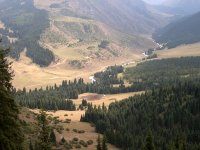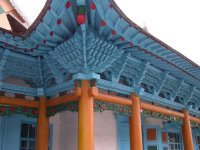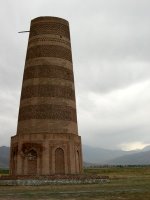Trip to Lake Issyk-Kul
We took advantage of a national day public holiday on 31 August to take a four-day break. Lake Issy Kul is the second largest alpine lake in the world, 160 kilometres long, and lies in a huge trough between the Kungey Alatau mountains to the north and the Terskey Alatau mountains to the south. A tour would have been impossible for us on our own—not speaking Russian is a great handicap. As it was, our tour company provided a jeep, driver and guide and we were looked after every step of the way. It was great—no worries about the logistics so could just relax and enjoy the scenery, the hikes and the places we visited.

The first night we experienced a yurt camp on the south shore of Issy Kul. I swam in the lake—cold but very clear. It's slightly salty and doesn’t freeze in the winter as they say it is fed by thermal springs. Then we split a bottle of Italian wine a friend had given us and watched the sun set over the lake.
The next day we drove on to Karakol, an old caravanserai town on the Silk Road to China. A detour took us up a gorge into the mountains for a hike from an astronauts recuperation camp in a wide valley reminiscent of Switzerland to a waterfall in the forest.

In Karakol, we were on the same longitude as China—which lay to the south of us over the mountains. The proximity to China and history as a Russian outpost were reflected in the very Chinese-temple looking mosque and a wooden Russian orthodox cathedral, as well as a museum dedicated to the Russian explorer Przewalski- the discoverer of the steppe-land horse that bears his name.

In Karakol, the architecture is very Russian, neat little decorated cottages.

On to the north shore of the lake and one of the Soviet-style sanitoria. A very weird experience, but very popular with Kazakh tourists from Almaty and groups of Russians from Ormsk. It’s actually quite comfortable and has lovely wooded gardens going down to a beach on the lake but is strangely regimented as to the meal times—where you can sit and what you can eat. We passed on the chicken and macaroni for breakfast.

Fortunately, now is the best time of year for fruit and vegetables so we stopped to buy apricots and grapes from roadside stalls. Other stalls sold smoked trout and salmon, but alas no fresh caught.

Another hike took us up into the mountains to the north of the lake. Here, the summer yurts were being dismantled—new snow had just fallen on the mountain tops with a change in the weather and folk were preparing to retreat down the valley for the winter. We were offered some fermented mare’s milk . . .
Back to Bishkek via another landmark on the Silk Route, the restored 11th century Birana Tower and Balasagan citadel. With views from the top of the tower of the Shamsy valley, plains stretching away to east and west and the snow capped mountains to the south, it was perhaps the most evocative of the places we visited—easy to imagine the caravans wending their way through.

 The first night we experienced a yurt camp on the south shore of Issy Kul. I swam in the lake—cold but very clear. It's slightly salty and doesn’t freeze in the winter as they say it is fed by thermal springs. Then we split a bottle of Italian wine a friend had given us and watched the sun set over the lake.
The next day we drove on to Karakol, an old caravanserai town on the Silk Road to China. A detour took us up a gorge into the mountains for a hike from an astronauts recuperation camp in a wide valley reminiscent of Switzerland to a waterfall in the forest.
The first night we experienced a yurt camp on the south shore of Issy Kul. I swam in the lake—cold but very clear. It's slightly salty and doesn’t freeze in the winter as they say it is fed by thermal springs. Then we split a bottle of Italian wine a friend had given us and watched the sun set over the lake.
The next day we drove on to Karakol, an old caravanserai town on the Silk Road to China. A detour took us up a gorge into the mountains for a hike from an astronauts recuperation camp in a wide valley reminiscent of Switzerland to a waterfall in the forest.
 In Karakol, we were on the same longitude as China—which lay to the south of us over the mountains. The proximity to China and history as a Russian outpost were reflected in the very Chinese-temple looking mosque and a wooden Russian orthodox cathedral, as well as a museum dedicated to the Russian explorer Przewalski- the discoverer of the steppe-land horse that bears his name.
In Karakol, we were on the same longitude as China—which lay to the south of us over the mountains. The proximity to China and history as a Russian outpost were reflected in the very Chinese-temple looking mosque and a wooden Russian orthodox cathedral, as well as a museum dedicated to the Russian explorer Przewalski- the discoverer of the steppe-land horse that bears his name.
 In Karakol, the architecture is very Russian, neat little decorated cottages.
In Karakol, the architecture is very Russian, neat little decorated cottages.
 On to the north shore of the lake and one of the Soviet-style sanitoria. A very weird experience, but very popular with Kazakh tourists from Almaty and groups of Russians from Ormsk. It’s actually quite comfortable and has lovely wooded gardens going down to a beach on the lake but is strangely regimented as to the meal times—where you can sit and what you can eat. We passed on the chicken and macaroni for breakfast.
On to the north shore of the lake and one of the Soviet-style sanitoria. A very weird experience, but very popular with Kazakh tourists from Almaty and groups of Russians from Ormsk. It’s actually quite comfortable and has lovely wooded gardens going down to a beach on the lake but is strangely regimented as to the meal times—where you can sit and what you can eat. We passed on the chicken and macaroni for breakfast.
 Fortunately, now is the best time of year for fruit and vegetables so we stopped to buy apricots and grapes from roadside stalls. Other stalls sold smoked trout and salmon, but alas no fresh caught.
Fortunately, now is the best time of year for fruit and vegetables so we stopped to buy apricots and grapes from roadside stalls. Other stalls sold smoked trout and salmon, but alas no fresh caught.
 Another hike took us up into the mountains to the north of the lake. Here, the summer yurts were being dismantled—new snow had just fallen on the mountain tops with a change in the weather and folk were preparing to retreat down the valley for the winter. We were offered some fermented mare’s milk . . .
Back to Bishkek via another landmark on the Silk Route, the restored 11th century Birana Tower and Balasagan citadel. With views from the top of the tower of the Shamsy valley, plains stretching away to east and west and the snow capped mountains to the south, it was perhaps the most evocative of the places we visited—easy to imagine the caravans wending their way through.
Another hike took us up into the mountains to the north of the lake. Here, the summer yurts were being dismantled—new snow had just fallen on the mountain tops with a change in the weather and folk were preparing to retreat down the valley for the winter. We were offered some fermented mare’s milk . . .
Back to Bishkek via another landmark on the Silk Route, the restored 11th century Birana Tower and Balasagan citadel. With views from the top of the tower of the Shamsy valley, plains stretching away to east and west and the snow capped mountains to the south, it was perhaps the most evocative of the places we visited—easy to imagine the caravans wending their way through.

No comments:
Post a Comment